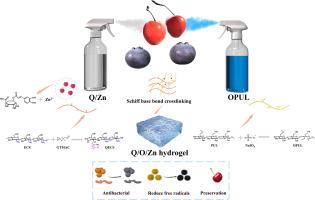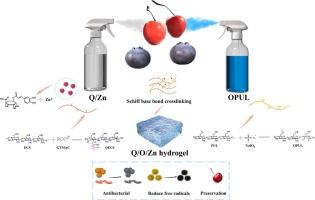一体机:利用多功能天然多糖喷雾水凝胶负载多酚金属纳米颗粒水果保存
IF 9.8
1区 农林科学
Q1 CHEMISTRY, APPLIED
引用次数: 0
摘要
水果保鲜材料在防止水果变质、延长保质期方面发挥着重要作用。然而,现有的保鲜材料往往不能同时实现抗菌、保鲜、抗氧化、良好的生物相容性和延长水果的保质期。因此,我们首次利用季铵昆虫壳聚糖(QECS)和氧化普鲁兰(OPUL)制备了一种天然多糖喷雾水凝胶(Q/O/Zn水凝胶),负载绿原酸锌纳米颗粒(CA@ZnNPs),用于保鲜易腐水果。结果表明,Q/O/Zn水凝胶对金黄色葡萄球菌和大肠杆菌的增殖有较好的抑制作用,同时对ABTS和DPPH自由基也有较强的清除能力。此外,水果保鲜试验表明,Q/O/Zn水凝胶在不同温度下显著降低了水果的呼吸速率、腐烂速率和重量损失,同时降低了水果表面有害细菌的物种多样性和丰度。Q/O/Zn水凝胶在水果保鲜方面具有广阔的应用前景。本文章由计算机程序翻译,如有差异,请以英文原文为准。


All-in-one: Harnessing multifunctional natural polysaccharide spray hydrogel loaded with polyphenol-metal nanoparticles for fruit preservation
Fruit preservation materials play an instrumental role in preventing fruit deterioration and extending shelf life. However, existing fresh-keeping materials often prove inadequate in simultaneously achieving antibacterial properties, maintaining freshness, antioxidant effects, good biocompatibility, and prolonged fruit shelf life. Therefore, we present the first preparation of a natural polysaccharide spray hydrogel (Q/O/Zn hydrogel), loaded with chlorogenic acid‑zinc nanoparticles (CA@ZnNPs), utilizing quaternary ammonium insect chitosan (QECS) and oxidized pullulan (OPUL) for the preservation of perishable fruits. The findings demonstrated that the Q/O/Zn hydrogel was highly effective in inhibiting the proliferation of S. aureus and E. coli, while also exhibiting remarkable scavenging capabilities about ABTS and DPPH radicals. Furthermore, the fruit preservation trials demonstrated that the Q/O/Zn hydrogel markedly reduced fruit respiration rates, decay rates, and weight loss across various temperatures while decreasing the species diversity and abundance of harmful bacteria on fruit surfaces. The Q/O/Zn hydrogel is promising for fruit preservation.
求助全文
通过发布文献求助,成功后即可免费获取论文全文。
去求助
来源期刊

Food Chemistry
工程技术-食品科技
CiteScore
16.30
自引率
10.20%
发文量
3130
审稿时长
122 days
期刊介绍:
Food Chemistry publishes original research papers dealing with the advancement of the chemistry and biochemistry of foods or the analytical methods/ approach used. All papers should focus on the novelty of the research carried out.
 求助内容:
求助内容: 应助结果提醒方式:
应助结果提醒方式:


